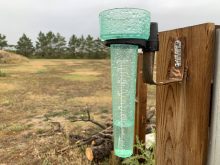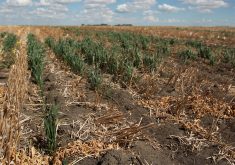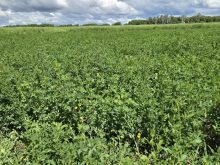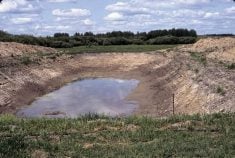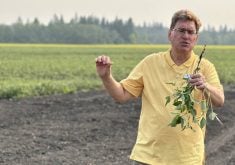Conditions across southern Alberta continue to challenge producers. Intermittent rains have hit some areas in July after being non-existent in May and June, and it’s become a crapshoot what crops and pasture will be able to benefit from the additional moisture.
“On our farm, there is a lot of uncertainty how we’re going to pull through,” said Rob Somerville, who farms and ranches in the County of Stettler. “I don’t want to throw my hands in the air and say, ‘this is the worst disaster ever,’ because so much is going to depend on rainfall from here to the next month. We’re on the verge of a crisis but if we get a rain, we’ll pull through.”
Read Also

Final crop reports show strong yields, quality
Crops yielded above average across the Prairies this year, and quality is generally average to above-average.
Stettler County on June 14 was the first in the province to declare a state of agricultural disaster because of the incredibly dry spring. In comparison, the county refrained from that declaration until August in 2021 when drought gripped most of Western Canada.
The combination of a light snowpack going into a cooler-than-normal spring for many parts of the province combined with a rare, prolonged spring heat wave, left the county’s dugouts empty and wetlands dry, leading to the early disaster declaration, according to the county.
Somerville said the situation for his operation is week-by-week waiting for rain to help his barley, corn and oats crops he uses for feed.
But with those failing and his canola cash crop also suffering, the situation has become desperate.
“When you’re thinking of taking canola and putting it out for silage, you’re kind of desperate,” said Somerville. “That’s what we’re looking at, that level of desperation; taking cash crops that we needed to pay bills, cash crops that were seeded to produce cash to pay bills, it gets diverted into feed if you are lucky, if it grows. And that changes our cash flows completely.”
Somerville said doubling the low thresholds by Alberta’s Agriculture Financial Services Corp. for cereal and pulse crops so they can be used for livestock feed will help, but it will still be hard to source feed past autumn.
Near Hilda, at the north end of Cypress County and a stone’s throw from the Saskatchewan border with Alberta, it’s much the same.
Cypress declared its state of agricultural disaster in July with the situation similar to that in Stettler County despite the irrigation in the southern portion of the rural municipality and decent soil moisture levels around the Cypress Hills.
Farmer Andy Kirschenman said expectations of 2023 building on the rebound from the 2021 drought have largely been doused.
“This was our year to turn it around, but it doesn’t look like that’s the case,” he said. “Right now, I think we have less rain than we did in 2021 or 2022 at this point in time.”
Kirschenman said out of his spring wheat, durum, peas and sunflower fields, the earlier-seeded crops are faring better. But grasshoppers are combining with the dry weather to put a dent in his expectations.
He said there is still an opportunity for timely rains to improve the situation, but likely not for peas and barley.
“But, as you drive further south, there is lots that no amount of rain is going to help this year anymore.”
Kirschenman said AFSC has been good at quickly turning around the time it takes for farmers to access the updated low-threshold levels so ranchers can access failing crops for feed, but feed from outside the area will still be needed.
In Vulcan County, which declared an agricultural disaster in late June, Kelly Malmberg, director of the municipality’s agricultural services department, echoed the sentiments of farmers and ranchers across southern Alberta.
“Overall, things look pretty bleak,” said Malmberg. “There are quarter sections where nothing came up.”
Next to no moisture in April and May and only spotty showers since then has led to poor pasture growth and late crop emergence.
“The thing that is really scary is the crop guys will probably limp through another year because the way things have been going the last couple of years, you’re crazy not to take crop insurance, but it is the cattle guys… there is no feed,” he said. “I don’t know what these guys are going to do for feeding cows.”
There are some spots in the western half of the county that Malmberg said are doing all right relative to the rest of the municipality. Some of the canola and pea fields look good, he said, but “it’s the cereals that really got hammered.”
Somerville said drought is part of farming but it appears to be happening more often and that is worrying.
“It seems like the droughts come faster,” he said. “We used to imagine we’d get a bigger break between droughts — like one in five years. Now maybe it’s one every other year or once every three years.”




